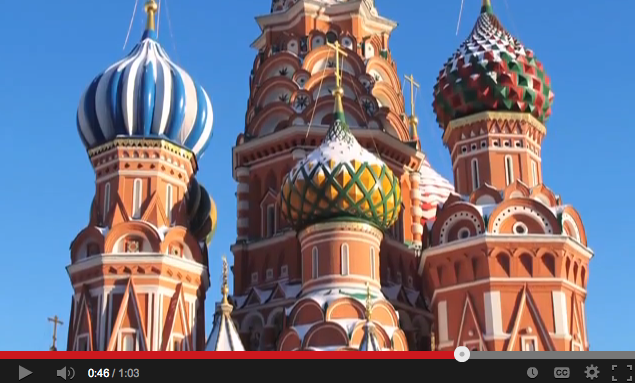Saint Basil’s Cathedral, Moscow, Russia

per Wikipedia (excerpt)
The Cathedral of the Protection of Most Holy Theotokos on the Moat (Russian: Собор Покрова пресвятой Богородицы, что на Рву) or Pokrovsky Cathedral (Russian: Покровский собор) are official names for a Russian Orthodox church in Red Square in Moscow.[5] The church is also called the Cathedral of St. Vasily the Blessed (Russian: Собор Василия Блаженного), anglicized as Saint Basil’s Cathedral. It was built from 1555–61 on orders from Ivan the Terrible and commemorates the capture of Kazan and Astrakhan.
St. Basil’s marks the geometric center of Moscow (not to be confused with the geographic center, the Ivan the Great Bell Tower). It has been the hub of the city’s growth since the 14th century[6][7] and was the city’s tallest building until the completion of the Ivan the Great Bell Tower in 1600.[8]
The original building, known as “Trinity Church” and later “Trinity Cathedral”, contained eight side churches arranged around the ninth, central church of Intercession; the tenth church was erected in 1588 over the grave of venerated local saint Vasily (Basil). In the 16th and 17th centuries the church, perceived as the earthly symbol of the Heavenly City,[9] as happens to all churches in Byzantine Christianity, was popularly known as the “Jerusalem” and served as an allegory of the Jerusalem Temple in the annual Palm Sunday parade attended by the Patriarch of Moscow and the tsar.[10]
The building is shaped as a flame of a bonfire rising into the sky,[11] a design that has no analogues in Russian architecture. Dmitry Shvidkovsky, in his book Russian Architecture and the West, states that “it is like no other Russian building. Nothing similar can be found in the entire millennium of Byzantine tradition from the fifth to fifteenth century … a strangeness that astonishes by its unexpectedness, complexity and dazzling interleaving of the manifold details of its design.”[12] The cathedral foreshadowed the climax of Russian national architecture in the 17th century.[13]
As part of the program of state atheism, the church was confiscated from the Russian Orthodox community as part of the Soviet Union’s anti-theist campaigns and has operated as a division of the State Historical Museum since 1928.[14] It was completely and forcefully secularized in 1929[14] and, as of 2012, remains a federal property of the Russian Federation. The church has been part of the Moscow Kremlin and Red Square UNESCO World Heritage Site since 1990.[15] It is often mislabelled as the Kremlin owing to its location on Red Square in immediate proximity of the Kremlin.[16]
The entire detailed Wikipedia article including several high quality images can be found here:
http://en.wikipedia.org/wiki/Saint_Basil%27s_Cathedral
A somewhat more detailed but still short video on the history and architecture of Saint Basil’s produced by the History Channel follows.
http://www.history.com/videos/building-st-basils-cathedral
